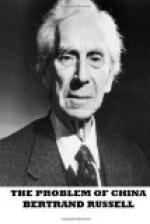The first census taken by the Manchus in 1651, after the restoration of order, returned China’s population at 55 million persons, which is less than the number given in the first census of the Han dynasty, A.D. 1, and about the same as when Kublai Khan established the Mongal dynasty in 1295. (This is presumably a misprint, as Kublai died in 1294.) Thus we are faced by the amazing fact that, from the beginning of the Christian era, the toll of life taken by internecine and frontier wars in China was so great that in spite of all territorial expansion the population for upwards of sixteen centuries remained more or less stationary. There is in all history no similar record. Now, however, came a vast change. Thus three years after the death of the celebrated Manchu Emperor Kang Hsi, in 1720, the population had risen to 125 millions. At the beginning of the reign of the no less illustrious Ch’ien Lung (1743) it was returned at 145 millions; towards the end of his reign, in 1783, it had doubled, and was given as 283 millions. In the reign of Chia Ch’ing (1812) it had risen to 360 millions; before the Taiping rebellion (1842) it had grown to 413 millions; after that terrible rising it sunk to 261 millions.
I do not think such definite statements are warranted. The China Year Book for 1919 (the latest I have seen) says (p. 1):—
The taking of a census by the methods adopted in Western nations has never yet been attempted in China, and consequently estimates of the total population have varied to an extraordinary degree. The nearest approach to a reliable estimate is, probably, the census taken by the Minchengpu (Ministry of Interior) in 1910, the results of which are embodied in a report submitted to the Department of State at Washington by Mr. Raymond P. Tenney, a Student Interpreter at the U.S. Legation, Peking.... It is pointed out that even this census can only be regarded as approximate, as, with few exceptions, households and not individuals were counted.
The estimated population of the Chinese Empire (exclusive of Tibet) is given, on the basis of this census, as 329,542,000, while the population of Tibet is estimated at 1,500,000. Estimates which have been made at various other dates are given as follows (p. 2):
A.D. A.D. 1381 59,850,000 / 143,125,225 1412 66,377,000 1760—203,916,477 1580 60,692,000 1761 205,293,053 1662 21,068,000 1762 198,214,553 1668 25,386,209 1790 155,249,897 / 23,312,200 / 307,467,200 1710 —27,241,129 1792- 333,000,000 1711 28,241,129 / 362,467,183 1736 125,046,245 1812—360,440,000 / 157,343,975 1842 413,021,000 1743 149,332,730 1868 404,946,514 \ 150,265,475 1881 380,000,000 1753 103,050,600 1882 381,309,000 1885 377,636,000
These figures suffice to show how little is known




